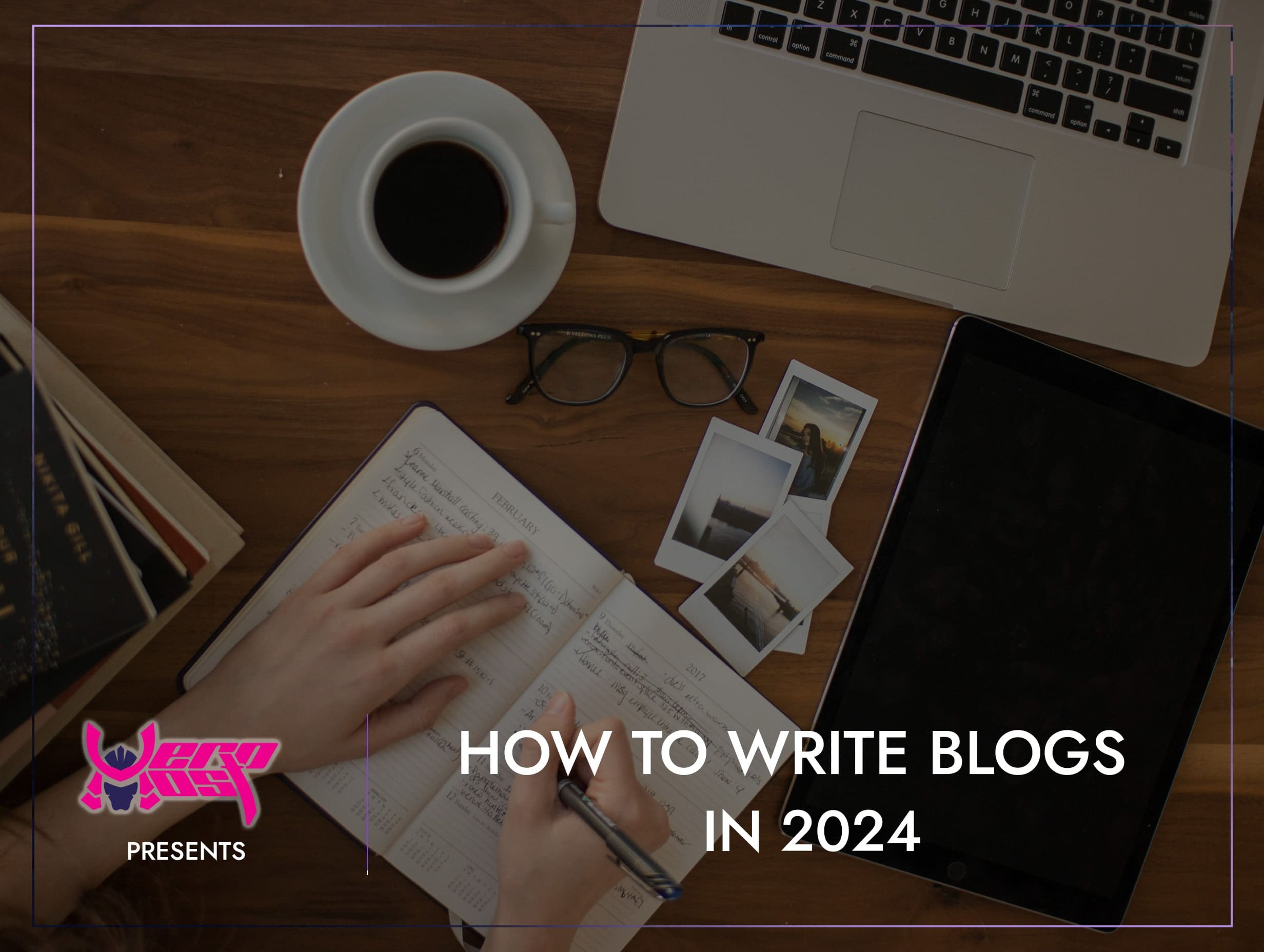How to Write a Blog in 2024
- Home
- Inbound Marketing
- How to Write a Blog in 2024

- Mikey Ryu
- February 5, 2024
- 0
How to Write a Blog in 2024
How to Write Blogs
Editing is the linchpin that transforms a draft into a polished and impactful piece of writing. In the realm of blogging, where content is king, the importance of the editing process cannot be overstated. It goes beyond mere correction of typos; it is the meticulous examination that ensures clarity, coherence, and an error-free narrative. As bloggers, we embark on a journey of refining our ideas, sharpening our communication, and ultimately delivering a product that not only captivates our audience but also establishes our credibility in the digital landscape. Let’s delve into the pivotal role of prioritising the editing process for creating blogs that resonate and stand out.
Benefits of blogs:
Personal Expression:
Blogging provides a platform for personal expression, allowing individuals to share their thoughts, experiences, and perspectives with a potentially global audience. It serves as a creative outlet for self-discovery and self-expression.
Building a Personal Brand:
Blogging is an effective tool for building a personal brand or establishing expertise in a particular niche. Consistent and insightful blog posts can position the author as an authority in their field, attracting opportunities for collaboration, speaking engagements, or career advancements.
Community Engagement:
Blogs facilitate interaction and engagement with a community of readers who share similar interests. Through comments and social media, bloggers can establish a dialogue with their audience, creating a sense of community around the topics they write about.
Skill Development:
Writing a blog involves honing various skills, including research, writing, editing, and content creation. It can also encourage the development of technical skills, such as managing a website, using multimedia tools, and understanding basic SEO principles.
Networking Opportunities:
Blogging opens doors to networking opportunities within the online community. Bloggers can connect with other influencers, professionals, and enthusiasts in their niche, fostering collaborations and expanding their network.
Portfolio Enhancement:
For writers, bloggers, and content creators, maintaining a blog serves as an ongoing portfolio that showcases their skills and expertise. This can be particularly valuable when seeking employment or freelance opportunities in the media, marketing, or writing industries.
Monetisation Potential:
Successful blogs can generate income through various channels, such as advertising, sponsored content, affiliate marketing, or selling products and services. While not every blog aims for monetization, those seeking additional income streams can leverage their platform for financial opportunities.
Considerations of Writing Blogs:
Target Audience:
Clearly define your target audience before writing a blog. Understanding who you are addressing helps tailor your content to meet their needs, interests, and preferences, making your blog more engaging and relevant.
Purpose and Goals:
Clearly articulate the purpose and goals of your blog. Whether you aim to inform, entertain, inspire, or sell a product, having a clear purpose guides your writing and ensures consistency in your content.
Content Quality:
Prioritise the quality of your content. Ensure that your writing is clear, concise, and free from grammatical errors. High-quality content not only attracts and retains readers but also enhances your credibility as a blogger.
SEO Optimisation:
Implement basic Search Engine Optimisation (SEO) practices to improve the discoverability of your blog. This includes using relevant keywords, creating descriptive meta-tags, and structuring your content in a way that search engines can easily understand.
Engaging Headlines and Introductions:
Craft compelling headlines and introductions to capture the reader’s attention. The first few sentences are crucial in retaining your audience, so make them interesting and relevant to encourage further reading.
Visual Appeal:
Incorporate visually appealing elements into your blog, such as images, infographics, and multimedia content. A well-designed and visually attractive blog enhances the overall user experience and makes your content more shareable.
Consistency and Frequency:
Establish a consistent publishing schedule. Regularly updating your blog with fresh content not only keeps your audience engaged but also contributes to improved search engine rankings. Set realistic goals for posting frequency to maintain quality while staying consistent.
How to Write a Blog That Resonates With Your Audience:
How to Find Your Blog Topics:
Finding compelling blog topics is a key element in maintaining an engaging and relevant online presence. Start by considering your passions, interests, and expertise. Your enthusiasm for a subject will naturally shine through in your writing. Additionally, analyse your target audience’s needs and interests. What questions are they asking, and what problems are they trying to solve? Conduct keyword research to identify trending topics in your niche, ensuring your content aligns with current search trends. Explore social media platforms and forums to understand the conversations happening within your community. Keep an eye on industry news and developments for timely and valuable content. Lastly, don’t be afraid to draw inspiration from your own experiences, whether personal or professional. Your unique perspective can add authenticity and depth to your blog, making it more relatable to your audience. Remember, the key is to strike a balance between addressing your audience’s needs and incorporating your authentic voice into the chosen topics.
How to Write For Your Audience:
Writing for your audience involves understanding their needs, preferences, and expectations to create content that resonates with them. Start by defining your target audience and researching their demographics, interests, and pain points. Tailor your writing style to match the tone and level of expertise your audience expects, whether it’s casual and conversational or formal and professional. Listen to feedback and engage with your audience through comments and social media to gain insights into their concerns and interests. Address their questions and challenges in your content, providing valuable solutions and insights. Use relatable examples and real-life scenarios to make your content more accessible and engaging. Consistency is key, so maintain a predictable posting schedule to keep your audience coming back for more. Ultimately, successful writing for your audience involves building a connection and delivering content that adds value to their lives or addresses their specific needs.
How Important Are Images & Video Inside of Blogs:
The inclusion of images and videos within blogs is of paramount importance as it significantly enhances the overall appeal and effectiveness of the content. Visual elements not only break up the text, making it more digestible for readers, but they also serve to illustrate and reinforce key points. Images and videos have the power to evoke emotions, clarify complex concepts, and create a more immersive experience for the audience. Visual content can also improve the retention of information, making the blog more memorable. Furthermore, in an age where attention spans are limited, compelling visuals grab the reader’s attention and encourage them to stay on the page. Additionally, search engines often prioritise content with multimedia elements, contributing to improved visibility and SEO performance. In essence, incorporating images and videos into blogs is instrumental in elevating the overall quality, engagement, and shareability of the content.
How to Finalise a blog:
Finalising a blog involves a careful review and refinement process to ensure that the content meets the desired standards and effectively communicates the intended message. Begin by revisiting the blog’s purpose and objectives, confirming that each section aligns with the overall theme. Check for clarity and coherence in your writing, ensuring that ideas flow logically and transitions between paragraphs are smooth. Pay close attention to grammar, spelling, and punctuation to maintain professionalism. Verify the accuracy of any facts or data presented and ensure proper attribution if external sources are used. Evaluate the visual elements, such as images or videos, to confirm they complement and enhance the written content. Consider seeking feedback from peers or trusted individuals to gain an external perspective. Finally, preview the blog on different devices to ensure a consistent and visually appealing presentation. By meticulously reviewing and refining your blog, you ensure that it not only meets your standards but also captivates and informs your audience effectively.
Key Tips:
Write The Introduction After:
Crafting an engaging introduction becomes notably challenging when the writer is uncertain about the direction their blog will take. The introduction serves as the gateway to the entire piece, setting the tone and providing readers with a glimpse of what to expect.
Define Your Purpose:
Clearly articulate the purpose of your blog. Whether it’s to inform, entertain, educate, or persuade, a well-defined purpose will guide your writing and resonate with your audience.
Know Your Audience:
Understand your target audience’s demographics, interests, and needs. Tailor your content to address their specific concerns and preferences, fostering a deeper connection with your readers.
Craft Compelling Headlines:
Create attention-grabbing headlines that not only capture the essence of your content but also entice readers to click and explore further. A compelling headline is crucial for drawing in your audience.
Structure for Readability:
Break up your content into digestible chunks with descriptive subheadings. Use short paragraphs, bullet points, and visuals to enhance readability. A well-structured blog keeps readers engaged and encourages them to stay on your page.
Incorporate Multimedia:
Enhance your blog with visually appealing elements such as images, videos, and infographics. Visual content not only makes your blog more attractive but also reinforces key points and increases overall engagement.
Be Authentic:
Infuse your unique voice and personality into your writing. Authenticity builds a connection with your audience, making your blog more relatable and memorable.
Edit and Revise:
Prioritise the editing process to ensure clarity, coherence, and error-free content. Review your blog for grammatical issues, factual accuracy, and overall flow. A well-edited blog enhances your credibility and professionalism.
In the dynamic world of online content creation, where attention spans are fleeting and the competition is fierce, the editing process emerges as the beacon guiding bloggers toward excellence. By scrutinizing our blogs for grammatical precision, factual accuracy, and overall narrative flow, we sculpt a finished product that not only meets high editorial standards but also elevates our professionalism. The commitment to a well-edited blog is a commitment to our audience, a promise that we value their time and offer them content worth consuming. In this pursuit, we not only enhance the readability of our work but also fortify our credibility as reliable sources of information and thought leaders in our respective niches. So, let the editing process be not just a formality, but a transformative journey toward creating blogs that leave a lasting impact.
Search
Categorys
- Branding (12)
- Business Growth Guides (3)
- Business Insights (3)
- Content Marketing (43)
- Domain Authority (19)
- Email Marketing (28)
- Google Analytics & Search Console (5)
- Hack or Not (2)
- Hero Host News (0)
- Inbound Marketing (32)
- Lessons From Asia (40)
- Marketing Guides (11)
- Martial Arts Journey (14)
- Outbound Marketing (8)
- Search Engine Optimisation (SEO) (41)
- Social Media Marketing (38)
- Web Design (20)
- Website Hosting (4)
- Wordpress (2)






